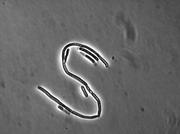Lifestyle switching – Bacillus cereus is able to resist certain antibiotic therapies

Light micrograph of B. cereus in a small colony variant. Photo: Markus Kranzler/Vetmeduni Vienna
A team from the Vetmeduni Vienna has now reported for the first time that B. cereus, following contact with certain antibiotics, can switch into a special slowed-down mode. The bacteria then form small colony variants (SVCs) that are difficult to diagnose and almost impossible to treat with certain antibiotics. This newly discovered mechanism may provide an alternative explanation for antibiotic resistance. The results were published in the journal mBio.
The bacterium B. cereus had so far been considered to be exclusively endospore-forming. In response to harsh conditions, the bacteria form protective endospores enabling them to remain dormant for extended periods. When conditions are more favourable, the endospores reactivate to become fully functioning bacteria.
Elrike Frenzel, Markus Kranzler and Monika Ehling-Schulz of the Institute of Microbiology at the University of Veterinary Medicine Vienna have now shown for the first time that B. cereus has an alternative lifestyle in the form of so called small colony variants (SCVs). In B. cereus these SCVs form in response to exposure with aminoglycoside antibiotics. SCVs grow slower than the original form of B. cereus. They have an altered metabolism and are resistant to those antibiotics which triggered this state, namely aminoglycosides.
“The bacterium protects itself against the harmful effects of the antibiotics by forming these Small Colony Variants. But B. cereus is usually treated with exactly those antibiotics which induce the SCV state. If an antibiotic triggers the formation of SCVs, it also triggers resistance,” first author Frenzel explains.
Rethinking therapy and diagnostics
The mechanism discovered by Frenzel, Kranzler and Ehling-Schulz is of enormous significance in clinical practice. Traditional diagnostic methods are based on the identification of metabolic features of B. cereus. These tests will not detect SCVs, however, as they have a slower, altered metabolism. This may result in incorrect antibiotic therapies or even failed diagnoses. Study author Frenzel sees molecular-based diagnostics as the only way to diagnose this form of B. cereus.
Treating B. cereus infections using only aminoglycoside antibiotics could bear the risk of a prolonged infection. SCVs grow more slowly, but they still produce toxins that are harmful to the body. “In this case, a combination therapy with other antibiotic groups is advisable,” Frenzel recommends.
New molecular mechanism of SCV formation
One species of bacteria that has been known for years to be a multiresistant hospital pathogen and which poses a life-threatening risk for immunocompromised individuals in particular is Staphylococcus aureus. Those bacteria also form SCVs, but unlike B. cereus they are capable of reverting to its original state. For B. cereus, the adaptation to a small colony variant appears to be final. “We believe that the SCV formation in B. cereus functions differently than in S. aureus,” says study author Ehling-Schulz.
Environmental niche to cope with stress
“The ability to form SCVs appears to be of environmental significance for the bacteria,” Frenzel believes. “This alternative lifestyle allows the bacteria to avoid threatening stress factors such as antibiotic exposure. B. cereus are soil-dwelling, and other microorganism in the soil produce antibiotics. Here, too, the formation of SCVs would be an advantage for the bacteria.”
Service:
Der Artikel „The Endospore-Forming Pathogen Bacillus cereus Exploits a Small Colony Variant-Based Diversification Strategy in Response to Aminoglycoside Exposure“ von Elrike Frenzel, Markus Kranzler, Timo D. Stark, Thomas Hofmann und Monika Ehling-Schulz wurde im Fachjournal mBio veröffentlicht. DOI:10.1128/mBio.01172-15
http://mbio.asm.org/content/6/6/e01172-15
About the University of Veterinary Medicine, Vienna
The University of Veterinary Medicine, Vienna in Austria is one of the leading academic and research institutions in the field of Veterinary Sciences in Europe. About 1,300 employees and 2,300 students work on the campus in the north of Vienna which also houses five university clinics and various research sites. Outside of Vienna the university operates Teaching and Research Farms. http://www.vetmeduni.ac.at
Scientific Contact:
Prof. Monika Ehling-Schulz
Unit of Functional Microbiology
University of Veterinary Medicine Vienna (Vetmeduni Vienna)
T +43 664 602576397
monika.ehling-schulz@vetmeduni.ac.at
Released by:
Heike Hochhauser
Corporate Communications
University of Veterinary Medicine Vienna (Vetmeduni Vienna)
T +43 1 25077-1151
heike.hochhauser@vetmeduni.ac.at
http://www.vetmeduni.ac.at/en/infoservice/presseinformation/press-releases-2015/…
Media Contact
All latest news from the category: Life Sciences and Chemistry
Articles and reports from the Life Sciences and chemistry area deal with applied and basic research into modern biology, chemistry and human medicine.
Valuable information can be found on a range of life sciences fields including bacteriology, biochemistry, bionics, bioinformatics, biophysics, biotechnology, genetics, geobotany, human biology, marine biology, microbiology, molecular biology, cellular biology, zoology, bioinorganic chemistry, microchemistry and environmental chemistry.
Newest articles

A ‘language’ for ML models to predict nanopore properties
A large number of 2D materials like graphene can have nanopores – small holes formed by missing atoms through which foreign substances can pass. The properties of these nanopores dictate many…

Clinically validated, wearable ultrasound patch
… for continuous blood pressure monitoring. A team of researchers at the University of California San Diego has developed a new and improved wearable ultrasound patch for continuous and noninvasive…

A new puzzle piece for string theory research
Dr. Ksenia Fedosova from the Cluster of Excellence Mathematics Münster, along with an international research team, has proven a conjecture in string theory that physicists had proposed regarding certain equations….



